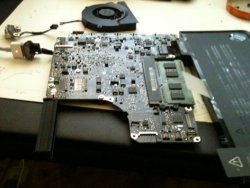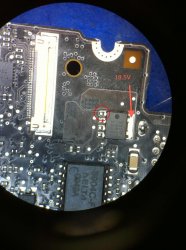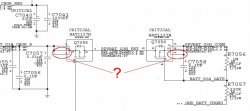Last week I cut off the end of magsafe plug from a broken Apple adapter and in the process of removing the plug sleeve, I broke the magnetic part from the circuit board part. There are 2 things I learned from this un-intentional damage. When I checked the end of the magsafe adapter cable without the plug, I saw open voltage of 6.25v. When I apply a 10 Ohm load to this wire, the voltage jumps up to 16.5v! So the Apple adapter is most likely still good and usable. It can sense a load and enable its output and provide voltage and current when low impedance is applied to the adapter.
Second lesson: maybe I have a bad DC IN board too like Kharlitro (my PN is 820-2565-A). I soldered two short wires to the +V and -V pins in the magnetic part. I use this to supply 16.5v to my MBP using a different (non-Apple) power supply and it did not do a thing to the MBP when I connected it, as if the externally supplied power is not even there (like a bad DC IN board). I did measure the accessible pins of the DC IN board, and I saw the 16.5v there, but to measure at the smaller plug end of the board, I have to take the logic board out, and I haven't done that yet. Stay tuned.
Second lesson: maybe I have a bad DC IN board too like Kharlitro (my PN is 820-2565-A). I soldered two short wires to the +V and -V pins in the magnetic part. I use this to supply 16.5v to my MBP using a different (non-Apple) power supply and it did not do a thing to the MBP when I connected it, as if the externally supplied power is not even there (like a bad DC IN board). I did measure the accessible pins of the DC IN board, and I saw the 16.5v there, but to measure at the smaller plug end of the board, I have to take the logic board out, and I haven't done that yet. Stay tuned.
Last edited:





